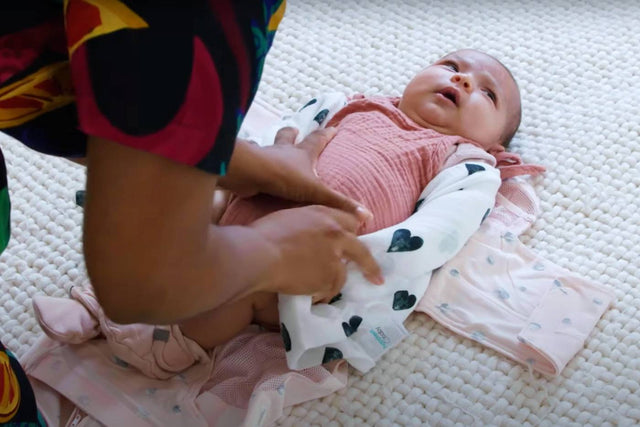How to Double Swaddle in SNOO

Swaddling is a gamechanger for infant sleep. Its snug hug mimics the gentle sensation your baby adored in the womb, which triggers their calming reflex, aka your baby’s “off switch” for fussing and “on switch” for sleep. It works like magic! That’s why SNOO features a built-in safe swaddle—plus soothing white noise and rocking—all of which has been shown to add 1 to 2 more hours of sleep each night.
The catch? Some spirited babies try to break out of SNOO’s swaddle—or wiggle an arm free—leading parents to wonder if their baby hates to be swaddled! But the truth is, if your baby fights their SNOO swaddle or frees an arm, there’s a good chance they simply need a snugger fit. Enter: The double swaddle! But before you reach for a second swaddle, know that it’s not safe to double swaddle your newborn with just any swaddle! Here, learn how to double swaddle in SNOO safely.
What is a double swaddle?
Whether you call it a double swaddle, a super swaddle, or a batwing swaddle, it’s all the same swaddling idea! In short, to double swaddle a baby in SNOO means you wrap them in a swaddle before securing them in their SNOO Sack.
Is it safe to double swaddle a newborn in SNOO?
It is safe to double swaddle in SNOO…when you do it correctly. That means following these safe SNOO double swaddle rules:
-
Never use more than two swaddle blankets.
-
Always choose a breathable swaddle, made of natural fabric to help keep babies cool and comfy all night.
-
Do not use a weighted swaddle.
-
SNOO Sack’s inner leg flap and arm bands must be securely fastened when double swaddling.
How to Double Swaddle a Baby in SNOO
Now that we’ve answered, “Can you use another swaddle with SNOO?” you are now likely wondering how to double swaddle in SNOO safely. Here, step-by-step instructions on how to do the SNOO double swaddle:
-
Select the proper swaddle: The best double swaddle for SNOO is a classic, lightweight, square organic cotton swaddle blanket, designed by pediatrician Dr. Harvey Karp. You can also opt for a muslin burp cloth or traditional cloth diaper.
-
Fold the blanket: If you are using a square swaddle blanket, fold it in thirds or fourths. You’ll only need enough fabric to wrap your baby’s arms. For those using a burp cloth or a classic cloth diaper, you can likely skip this step.
-
Lay out your swaddles: Place your unzipped SNOO Sack on a flat surface and spread the inner bands open. Next, put the folded thin blanket or cloth diaper on top of the SNOO Sack.
-
Check Baby’s position: Lay your baby down on top of the folded blanket, ensuring their shoulders are at the top of the folded blanket and about 2 inches higher than the top of the SNOO Sack.
-
Wrap your baby’s arms: Gently hold down one of your baby’s arms and fold one side of the blanket over your baby’s arm, tucking it underneath that same arm. Repeat on the other side.
-
Secure the SNOO Sack: Once both of your baby’s arms are secured by the swaddle blanket, pull SNOO Sack’s inner arm bands across your baby’s chest, keeping their arms straight at their sides. (The bottom edge of the sack's bands should cover your baby’s wrists.) Next, bring the lower flap between your baby’s legs and attach it to the inner band. Pull the sack up and over your baby’s feet and shoulders and zip completely closed. (The top of the zipper should be positioned well below your little one’s chin.)
-
Engage safety clips: Now that your baby is double swaddled, place them in SNOO, sliding SNOO Sack’s patented looped “wings” onto SNOO’s built-in safety clips. Once your precious bundle is clipped into the bassinet, you can rest assured they’ll remain safely on their back all sleep long.
Video: Learn How to Double Swaddle in SNOO